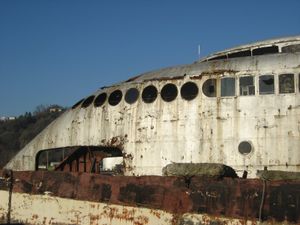MV Kalakala
| MV KALAKALA (ferry) | |
|---|---|
| U.S. National Register of Historic Places | |
|
The MV Kalakala, pictured in an early promotional postcard (c. 1935)
| |
| Location: | Hylebos Creek Waterway, 1801 Taylor Way Tacoma, Washington |
| Coordinates: | 47°16′30″N 122°23′11″W / 47.275°N 122.38639°WCoordinates: 47°16′30″N 122°23′11″W / 47.275°N 122.38639°W |
| Added to NRHP: | March 22, 2006 |
| NRHP Reference#: | 06000177 |
The MV Kalakala was a ferry that operated on Puget Sound from 1935 until her retirement in 1967.
Kalakala was notable for her unique streamlined superstructure, art deco styling, and luxurious amenities. The vessel was a popular attraction for locals and tourists, and was voted second only to the Space Needle in popularity among visitors to Seattle during the 1962 Seattle World's Fair. The ship is known as the world's first streamlined vessel for its unique art deco styling.
Service
She was constructed in 1926 as Peralta for the Key System's ferry service on San Francisco Bay. On 6 May 1933 Peralta burned as a result of an arson fire at the terminal where she was moored, resulting in the complete destruction of her superstructure. The hull was still intact and on 12 October 1933 the vessel was sold to the Puget Sound Navigation Company (PSNC), also known by its marketing name, the "Black Ball Line". PSNC funded a refit to restore the vessel as a ferry.[1]
In November 1934, William Thorniley, publicist for PSNC and president of the Olympic Peninsula Travel Association, named the new ferry Kalakala, which was said to mean "bird" in the Pacific Northwest Native American trade language Chinook Jargon.[2][3][4][5] Thorniley launched a national promotional campaign beginning with large billboard signs that simply said "KALAKALA!" Later, they said "KALAKALA, Seattle, WA" and featured a picture of the vessel as well.[citation needed]
The new bridge and wheelhouse were built entirely out of copper, from fear that the steel used in the rest of the vessel would interfere with the ship's compass.[6] Set back from her streamlined superstructure for aesthetics, it was impossible to see the bow of the vessel from the bridge. As visibility also depended on round portholes rather than a fully-glazed wheelhouse, she was known for being difficult to handle when docking.
Kalalaka was well known for a heavy shaking vibration that ran throughout the vessel when in operation. This was probably due to poor alignment of the engines in the original construction of the vessel. Although the company wished the vessel to be known as the Silver Swan, the vessel soon attracted other, less complementary nicknames, including the Silver Slug, Silver Beetle, Galloping Ghost of the Pacific Coast, and, among Seattle's Scandanavian community, Kackerlacka, which means "cockroach".[7]
In February 1946, Kalakala was issued Federal Communications Commission (FCC) license #001 for the first commercial radar system.[8]
Retirement
After her retirement in 1967, the vessel was sold to a seafood processing company and towed to Alaska to work as a factory ship. After working as a crabbing ship for a couple of years, the Kalakala was beached in Kodiak, Alaska in 1970 and used to process shrimp.
Peter Bevis discovered the rusting hulk on a fishing trip in 1984. The Kalakala had been turned into a cannery and the internal structure had been reworked to create a building with cement floors, drywall, and ceiling tiles. After complicated financial negotiations and hard work, they managed to refloat her and tow her back to Seattle in 1998. The vessel has since been a source of controversy as her owners were unable to raise sufficient funds to refurbish the vessel or even to keep her moored in Seattle's Union Bay.
The vessel was sold in 2004 to a private investor, who moved her to an anchorage in Neah Bay provided by the Makah Tribe. Soon after arriving at Neah Bay the Kalakala was evicted by the Makah, who also brought a lawsuit against the owners. The vessel has since been relocated to Tacoma, Washington.

In February 2008, Kalakala owner Steve Rodrigues announced his intention to acquire additional vintage ferry vessels and to restore them and the Kalakala as either ferries powered by wind and solar technologies or as museums. The Kalakala is currently scheduled for work on its hull and superstructure in dry dock in 2010.[9]
Artistic projects
Several art projects arose from their fascination with the Kalakala, including a full-length album of solo cello compositions recorded onboard the vessel in November 2003, called "Songs From a Parallel Universe." There is also an as-yet unreleased film, also filmed on the Kalakala, about the "Ghost Dance."
There was also a live concert featuring the Icelandic band múm, Serena Tideman and Eyvind Kang, on board the Kalakala.
A temporary "pirate radio" station broadcasting from the Kalakala is featured in the 2005 documentary film "Pirate Radio"
References
- ↑ Kline, Mary Stiles; Bayless, G.A. (1983). Ferryboats — A Legend on Puget Sound. Seattle: Bayless Books. pp. 225–226. ISBN 0-914515-00-4.
- ↑ http://www.gutenberg.org/files/15672/15672-8.txt
- ↑ http://www.rjholton.com/PDFs/Ec1.PDF
- ↑ "Chinook jargon". http://chinookjargon.home.att.net/shaw.htm.
- ↑ Kline, Ferryboats p. 229
- ↑ Kline, Ferryboats p. 231
- ↑ Kline, Ferryboats pp. 244-245.
- ↑ "radar set in Kalakala". HistoryLink. http://historylink.org/index.cfm?DisplayPage=output.cfm&file_id=9282.
- ↑ Jerry Cornfield (2 February, 2008). "Kalakala owner has a vision for old ferries". HeraldNet. http://www.heraldnet.com/article/20080202/NEWS01/814676473.
External links
- Pages with broken file links
- All articles with unsourced statements
- Articles with unsourced statements from August 2008
- Articles with invalid date parameter in template
- Washington State Ferries vessels
- Art Deco ships
- National Register of Historic Places in Tacoma, Washington
- Ships on the National Register of Historic Places
